 |
 |
 |
| |
(NIH Study) Circulating Markers of Endothelial Dysfunction, Coagulation and Tissue Fibrosis Prior to Incident Venous Thromboembolism in Patients with HIV Infection
|
| |
| |
Reported by Jules Levin
CROI 2011 March 2 Boston
Laura Musselwhite*1,2, V Sheikh1, T Norton1, A Rupert3, B Porter4, S Penzak1, J Skinner1, J Mican1, C Hadigan1, and I Sereti1
1NIAID, NIH, Bethesda, MD, US; 2Duke Univ Sch of Med, Durham, NC, US; 3SAIC-Frederick, Inc, MD, US; and 4FDA, Silver Spring, MD, US

Introduction:
HIV-infected patients are at substantially increased risk of venous thromboembolism (VTE) that may be related to chronic inflammation and coagulation abnormalities induced by HIV infection and concurrent opportunistic infection. It has been shown that higher plasma levels of coagulation and inflammatory biomarkers predicted mortality, cardiovascular, and opportunistic disease in HIV. In this study, we investigated the relationship between VTE and HIV-related characteristics, traditional risk factors of hypercoagulability, and pre- event levels of biomarkers.
Venous thromboembolism; Lung blood clot; Blood clot - lung; Embolus; Tumor embolus; Embolism - pulmonary
A pulmonary embolus is a blockage of an artery in the lungs by fat, air, a blood clot, or tumor cells.
A pulmonary embolus is most often caused by a blood clot in a vein, especially a vein in the leg or in the pelvis (hip area). The most common cause is a blood clot in one of the deep veins of the thighs. This type of clot is called a deep vein thrombosis (DVT).
Less common causes include air bubbles, fat droplets, amniotic fluid, or clumps of parasites or tumor cells, all of which may lead to a pulmonary embolus.
People with certain clotting disorders may also have a higher risk.
Circulating Markers of Coagulation, Endothelial Dysfunction, and Tissue Fibrosis Prior to Incident Venous Thromboembolism in Patients with HIV Infection
Laura Musselwhite*1,2, V Sheikh1, T Norton1, A Rupert3, B Porter4, S Penzak1, J Skinner1, J Mican1, C Hadigan1, and I Sereti1
1NIAID, NIH, Bethesda, MD, US; 2Duke Univ Sch of Med, Durham, NC, US; 3SAIC-Frederick, Inc, MD, US; and 4FDA, Silver Spring, MD, US
ABSTRACT
Background: HIV-infected patients are at a substantially increased risk of venous thromboembolism (VTE) that may be related to chronic inflammation and coagulation abnormalities. Biomarkers may help identify patients at risk and characterize the pathophysiology of hypercoagulability in HIV.
Methods: We identified 23 subjects with a first incident VTE event. HIV+ controls were matched to cases in a 3:1 ratio (n = 69) by age (± 5 years), sex, and duration of follow-up. Traditional risk factors and HIV-associated variables were assessed. Markers of endothelial dysfunction, inflammation, coagulation, and tissue fibrosis were measured using the most recent plasma available prior to the matching event (25 vs 34 days for cases and controls; p = 0.26). Non-parametric Mann to Whitney U test and Fisher's exact test were used for comparisons.
Results: Traditional risk factors, including the presence of active infection (57% in cases vs 15% in controls p = 0.0002) and provocation (trauma, indwelling catheter and hospitalization) (35% vs 9%, p = 0.006) were significantly increased in cases while smoking, body mass index, and prevalence of malignancies did not differ between the groups. Low nadir CD4 T cell count (40 vs 250 cells/mL, p = 0.0003), immunological AIDS (35% vs 12%, p = 0.02), and a history of >1 lifetime opportunistic infection (52% vs 22%, p = 0.008) or clinical cytomegalovirus (CMV) disease (22% vs 2%, p = 0.003) were strongly associated with VTE while recent CD4 T cell count (507 vs 517 cells/mL, p = 0.30) and HIV RNA (2.7 log10 copies/mL vs 1.7 log10 copies/mL, p = 0.36) were not. Cumulative exposure to ARV agents (6.9 vs 7.2 years, p = 0.63), ARV regimen, and interleukin (IL) -2 use (35% vs 29%, p = 0.61) were not related to VTE. Biomarker values are shown:

Conclusions: Venous thromboembolic disease in HIV is associated with severe immunodeficiency in addition to active infection and provocation. Higher levels of D-dimer, P-selectin, and hyaluronic acid independently predict VTE risk in HIV.



|
| |
|
 |
 |
|
|